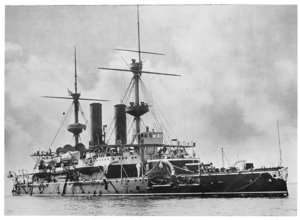HMS Hood (1891)
|
|

| ||
| Career | 
| |
|---|---|---|
| Ordered: | 1889 | |
| Laid down: | August 17, 1889 | |
| Launched: | 30 July 1891 at Chatham Dockyard, England | |
| Commissioned: | 1 June 1893 | |
| Decommissioned: | 1914 | |
| Fate: | sunk as a blockship in Portland harbour, 1914 | |
| Struck: | ||
| Specifications | ||
| Displacement: | 14,190t; 15,580t full load | |
| Length: | 410ft 5in oa x 75ft x 27ft 6in (125m oa x 22.8m x 8.4m) | |
| Armament: | 4-13.5in (343mm) 67-ton (2x2);
10-6in (152mm) (10x1); 10-6pdr (10x1); 12-3pdr (12x1); 6-18in Torpedo Tubes (4 above water, 2 underwater) | |
| Armour: | Belt 18in (457mm) compound, deck 3in (76mm), turret 17in (432mm) | |
| Propulsion: | Twin coal-fired Humphreys & Tennant 3-cylinder triple-expansion steam engines, two screws; 9000iHP = 15.7kts max. | |
| Range: | ||
| Complement: | 712 | |
| Motto: | ||
The second warship to be named HMS Hood was a modified Royal Sovereign-class battleship of the Royal Navy, and the last of the eight built.
She was named after Admiral Sir Arthur William Acland Hood, First Lord of the Admiralty 1885–1889. In their day, the battleships of the Royal Sovereign class were the largest warships ever built. The other two Hoods were named after an earlier relative, Admiral Samuel Hood, 1st Viscount Hood.
Hood differed significantly from the other Royal Sovereigns in that she had a freeboard of only 11 feet 3 inches compared to 19 feet 6 inches of the other members of the class. The Royal Sovereigns had reverted to a higher freeboard after several classes of low freeboard vessel had been constructed, the last being the Trafalgar class. Low freeboard had been popular for around ten years since it gave a smaller hull area to armour and made a smaller target for gunfire to hit, although it had the disadvantage that it reduced seaworthiness.
This small freeboard meant that Hood was very wet in rough weather and her maximum speed reduced rapidly as the wave height increased, making her only suitable for service in the relatively calm Mediterranean. This was seen as a vindication of the barbette/high-freeboard design in the rest of her class, and all subsequent British battleship classes had high freeboard. In part this was also due to the Entente Cordiale between France and Great Britain in which France took over defence of the Mediterranean and the Royal Navy was concentrated in the rougher home waters around the United Kingdom.
Because the stability of a ship is largely due to freeboard at high rolling angles, she was given a larger metacentric height (the vertical distance between the centre of buoyancy and the centre of gravity above it) of around 4.1 feet instead of the 3.6 feet of the rest of the Royal Sovereigns to make her roll less in rough seas. This had the effect of making her roll period shorter by around 7% compared to her sisters, which in turn made her gunnery less accurate.
Nevertheless the higher positioning of the centre of gravity and the lower freeboard allowed the main aramament guns and gun crews to be protected by armoured turrets rather than having the guns exposed on top of barbettes as the other members of the class — the turrets adding to the amount of weight high up in the ship compared to barbettes.
The upper 6 inch gun deck in the other Royal Sovereigns was enclosed in casemates in 1901-1902 replacing the original gun shields, but the stability of the Hood was considered insufficient for this modification.
Missing image
Hood.gif
Plan and elevation of Hood
After nearly a decade in the Mediterranean fleet, she was moved to home waters, first with the Home Fleet, then the Reserve Fleet at Devonport. From 1910 to 1913 she was flagship of the senior officer on the coast of Ireland, and then became a test ship for the successful experiments with anti-torpedo bulges later widely adopted.
On 4 November 1914, shortly after the outbreak of World War 1 she was scuttled in Portland harbour to block the Southern Ship Channel, a potential access route for U-boats or for torpedoes fired from outside of the harbour. The intention had been for her to gradually settle on the seabed with her seacocks open but she took so long to sink that the tide turned and she started to be pulled out of position, and consequently explosives were quickly used to blow a hole in her hull. The wreck lies upside down, a common position for sunken battleships because of the weight of the turrets.
The wreck was popular with local scuba divers until diving there was banned at the beginning of January 2004 for safety reasons [1] (http://www.portland-port.co.uk/press-release-hood.htm).
See HMS Hood for other ships of the same name.
References
- D. K. Brown, Warrior to Dreadnought, Warship Development 1860-1906, ISBN 1840675292
- Roger Chesneau and Eugene M. Kolesnik, ed., Conway's All The Worlds Fighting Ships, 1860-1905, (Conway Maritime Press, London, 1979), ISBN 0851771335
